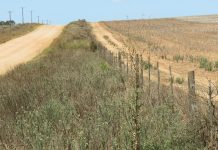
A total of 890 composite samples, representing white and yellow maize of each production region, were received and analysed to determine their quality. The samples consisted of 516 white and
374 yellow maize samples. The results of this 23rd survey as well as previous years’ surveys are available on the website of the Southern African Grain Laboratory NPC (SAGL) at www.sagl.co.za.
RSA grading
The maize crop, although the second largest in history, was of below average quality for the second consecutive season. Only 43% of the white maize samples analysed were graded as maize grade one – last season this figure was 58%. 65% of yellow maize samples analysed were graded as grade one, compared to the 77% of the previous season.
Percentage total defective kernels above and below the 6,35 mm sieve – 10,1% for white and 6,6% for yellow maize – was respectively 1,4% and 1,2% higher than the previous season. Defective white maize kernels above the 6,35 mm sieve made the largest contribution to the increase in the percentage total defective kernels, increasing from 6,8% last season to 8,1% this season. The percentage defective kernels below the 6,35 mm sieve for white maize increased from 1,8% to 2,0% and that of yellow maize from 1,7% to 2,3%. The average percentage Diplodia-infected kernels in white maize decreased from 0,4% to 0% this season and in yellow maize from 0,9% to 0%. Fusarium-infected kernels increased for both white and yellow maize compared to the previous season, from 0,3% in both white and yellow maize to 0,8% and 0,7% respectively.
The number of white maize samples that were downgraded to class other maize as a result of the percentage foreign matter exceeding 0,75%, increased from 23 samples to 38 samples this season. The number for yellow maize decreased from 18 samples to 14 samples this season. Two white and three yellow maize samples were downgraded as a result of other colour maize that exceeded 10% and 5% (maximum permissible deviation for grade three) respectively. The average percentage combined deviations of white maize was 10,7% compared to the 9,3% of the 2018/2019 season and that of yellow maize was 6,9% compared to 5,7% previously.
Physical quality characteristics
Bushel weight/test weight is applied as a grading factor in the USA grading regulations and is also routinely done at most intake points locally for stock verification purposes. White maize had an average test weight of 75,6 kg/hl compared to the 76,3 kg/hl of yellow maize. White and yellow maize’s average test weight was respectively 0,3 kg/hl and 0,6 kg/hl lower than in the previous season. The test weight in total varied from 63,4 kg/hl to 82,4 kg/hl.
The 100-kernel mass (‘as is’ basis) of white maize was 34,9 g (33,4 g in 2018/2019) and averaged higher than yellow maize (30,4 g with last season 30,6 g) like in previous seasons. The percentage white maize kernels above the 10 mm sieve increased by 3,2% compared to the previous season. The percentage yellow maize kernels above the 10 mm sieve was similar to last season, increasing from 8,3% to 8,4%. The percentage yellow maize kernels above the 10 mm sieve was on average 19,4% lower than white kernels and the percentage yellow kernels below the 8 mm sieve was 16,3% higher than that of white maize.
White maize was slightly less susceptible to breakage than during the previous season. The percentage yellow maize below the 6,35 mm and 4,75 mm sieves was equal to the previous season. The percentage stress cracks observed varied overall from 2% to 58% and averaged 16% for white and 13% for yellow maize, previously 17% and 13% respectively. The average stress crack percentages over the last two seasons were the highest of all the seasons since 1999/2000 when stress crack analyses commenced.
The milling index obtained from the SAGL Milling Index 2020 model, varied from an average of 73 (79 in 2018/2019) for white maize to 77 (previously 80) for yellow maize. Grit yield all (GYA) values averaged 63 for white maize and 64 for yellow maize (64 and 65 respectively in 2018/2019).
Roff milling and whiteness index
The average percentage extraction of total meal in white maize obtained with the Roff mill averaged 76,2% (0,2% higher than the previous season) and varied from 65,3% to 80,4%.
The whiteness index (WI) averaged 31,8 for unsifted and 21,8 for sifted maize meal. Sieving the sample eliminates differences in the readings as a result of particle size. The whiteness index of the previous season averaged 30,2 and 20,3 for unsifted and sifted maize meal respectively.
Higher WI values mean whiter meal samples. The main contributing factors causing differences in WI values are the presence of other colour maize like yellow maize, the presence of defective kernels, the type of cultivar as well as the soil composition. The two samples with the lowest sifted whiteness index values this season, namely -19,06 and -17,02, also had the highest percentages other colour maize, namely 18,3% and 13,5% respectively.
Nutritional values
The crude fat, crude protein, crude fibre and total starch nutritional components are reported as a percentage (g/100 g) on a dry base. The average fat content of white maize equalled the 4,0% of the previous season. Yellow maize averaged 3,9% – 0,1% lower than the previous two seasons. The ten-year average fat content of white maize is 4,1% and that of yellow maize 3,9%. The average protein content of yellow maize was 9,0%, while white maize averaged 8,4%, the lowest since the 2010/2011 season. The ten-year averages for yellow and white maize respectively are 9,0% and 8,8%.
Average starch content of both white maize (73,2%) and yellow maize (72,3%) was 0,4% lower than in the previous season. Ten-year averages for white and yellow maize are 73,0% and 72,8% respectively. The average crude fibre content of white maize was equal to last season’s 1,9% and that of yellow maize was 0,1% lower at 1,9%.
Mycotoxins
The multi-mycotoxin results of 350 maize samples tested were reported. The samples were selected to represent white and yellow maize from all the production regions for the analysis of 13 mycotoxins. These mycotoxins include aflatoxin B1, B2, G1 and G2, fumonisin (FUM) B1, B2 and B3, deoxynivalenol (DON), 15-acetyl-deoxynivalenol (15-ADON), ochratoxin A, T2-toxin, HT-2-toxin and zearalenone (ZON). The multi-mycotoxin results over ten consecutive seasons provide an excellent perspective of South African commercially produced maize. Notable trends in the presence of specific mycotoxins in different production regions, the concentration ranges found and occurrence in white and yellow maize are observed over production seasons.
This season, 90% of the samples (316 samples) contained one or more mycotoxin, mainly DON (85%), FUM (35%) and ZON (13%). The presence of DON and ZON increased over the past five seasons. In 2015/2016 only 23% and 5% of the samples contained DON and ZON, respectively. The FUM prevalence decreased over the same period, from 57% in 2015/2016 to 35% this season.
In three of the seven provinces represented by the samples, namely the Northern Cape, Limpopo and KwaZulu-Natal (KZN), all the samples tested contained mycotoxins. An increase in the occurrence of mycotoxins was found in the other four provinces this season. Only one white maize sample was received from the Eastern Cape. This sample was contaminated with DON, 15-ADON and ZON and the DON concentration was more than the regulated maximum allowable level of 2 000 µg/kg.
The results obtained with the LC-MS/MS instrument, including the range of concentration levels and notable trends in the mean concentration levels in white and yellow maize in the different provinces, are summarised as follows:
Aflatoxins
Only one yellow maize sample collected in the North West Province in region 12, was contaminated with 10 µg/kg aflatoxin B1. Previously, aflatoxins were found in one white maize sample collected in 2018/2019 in the Free State and also in three white maize samples collected in the North West Province in the 2014/2015 season.
Ochratoxin A, T2-toxin and HT-2-toxin
None were reported in locally produced commercial maize since the mycotoxin survey began in 2010/2011.
DON and 15-ADON
Approximately 87% white maize and 83% yellow maize samples contained DON – a steep increase compared to previous seasons. The percentage of white maize samples that contained more than 2 000 µg/kg DON, the national regulated maximum allowable level in unprocessed maize for human consumption, increased to 8%. These white maize samples were collected in North West (4), the Free State (6), Mpumalanga (2), Gauteng (3) and KZN (1).
In contrast to the previous season, the white maize samples with the highest DON concentrations were collected in North West (7 526 µg/kg) and the Free State (7 700 µg/kg). The highest DON concentration (5 060 µg/kg) reported on yellow maize over the past ten seasons, was found in North West this season.
The annual mean DON concentrations of the positive white maize samples increased significantly in four provinces and with regards to yellow maize in five provinces. Limpopo reported no DON residues in white maize, but in contrast mean values as high as 1 583 µg/kg and 1 463 µg/kg were reported in the Northern Cape and Gauteng respectively.
15-ADON is always present in samples that contain DON, mostly when the DON concentration exceeds 500 µg/kg. Due to the increase in DON concentrations, a 16% increase in 15-ADON occurrence was reported. This season 34% of the 350 samples tested contained 15-ADON, with a mean concentration of 208 µg/kg.
Fumonisins (FUM total = FB1 + FB2 + FB3)
This season only 28% of the white maize samples contained FUM, showing a continuous decrease in contamination from the 62% in 2015/2016. In contrast, more yellow maize samples contained FUM – approximately 43% – similar to the previous four seasons.
The highest concentration FUM measured in white maize (3 911 µg/kg) was just slightly less than the national regulated maximum allowable level in unprocessed maize for human consumption, namely 4 000 µg/kg. A yellow maize sample from the Northern Cape with a concentration of 5 928 µg/kg exceeded this level.
A decrease was observed in the white maize mean FUM concentration in three of the seven provinces over the last three production seasons. The mean FUM concentration in yellow maize ranged from 239 µg/kg in KZN to 1 092 µg/kg in the Northern Cape and increased only slightly in North West and the Free State.
Zearalenone
ZON was not found in Limpopo nor in the yellow maize produced in Gauteng. ZON was found for the first time in white maize produced in the Northern Cape. The highest concentration ZON in an individual white maize sample since commencement of the survey in 2010/2011, namely 539 µg/kg, was reported this season in a sample from the Free State.
Sincere appreciation to the Maize Trust for financial support of these annual surveys and to the members of Agbiz Grain for providing the maize crop samples.




























